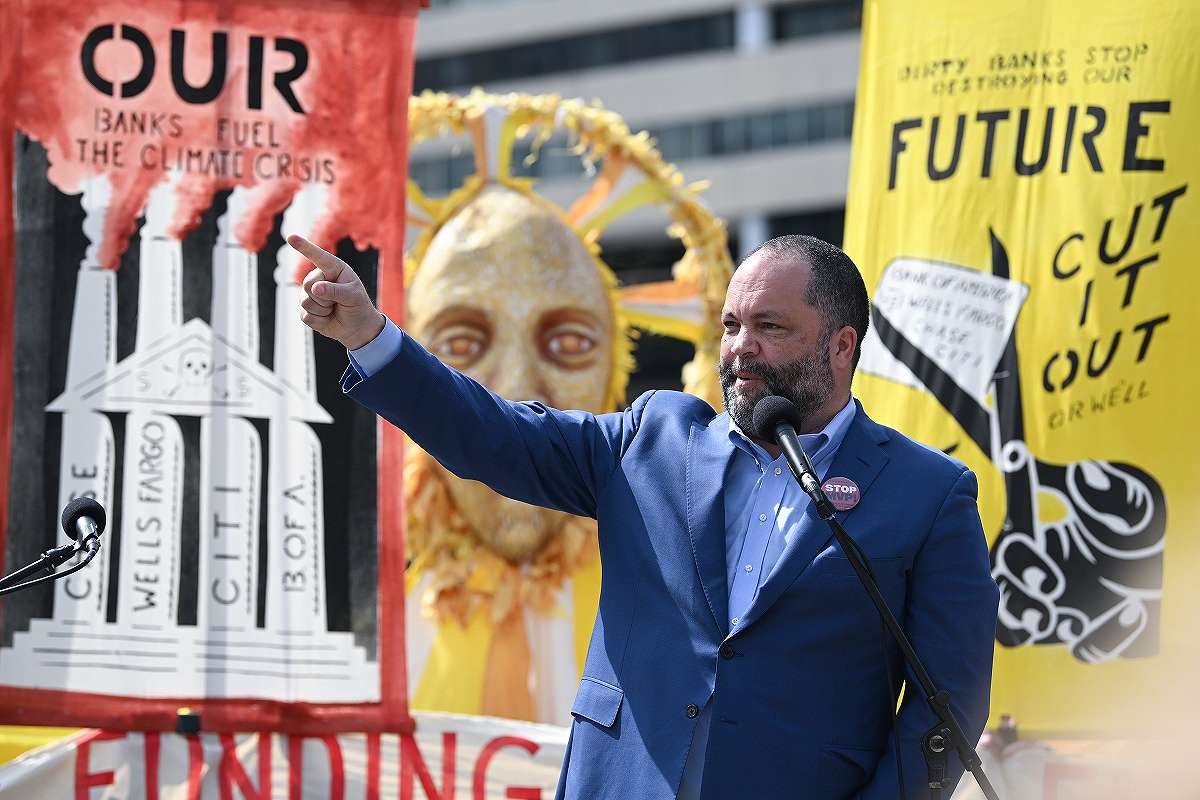
Sierra Club Executive Director Ben Jealous speaks during a protest of big banks financing fossil fuels in March in Washington.
14:00 JST, September 8, 2023
When Ben Jealous became the first person of color to lead the Sierra Club, the prominent civil rights leader promised to create more inclusive working conditions at the nation’s oldest environmental group.
“We have to deal with all of the equity issues inside the Sierra Club,” he said in January. “Those include, absolutely, issues of gender, as well as racial equity and also pay equity.”
But today, the 131-year-old group is in turmoil over its approach to diversity, equity and environmental justice, according to interviews with 12 current and former staffers, most of whom spoke to The Washington Post on the condition of anonymity for fear of facing retaliation or otherwise harming their job prospects.
The tumult illustrates the challenges top environmental groups face in trying to diversify their staffs, despite their recent efforts to reckon with the conservation movement’s legacy of racism. After coming under scrutiny for not doing enough to promote employees of color and fight pollution that disproportionately hurts minority communities, even organizations that have shifted course find themselves embroiled in fights over how to address past wrongs and ensure equity.
The discord at the Sierra Club intensified in April and May, when the group’s new leadership laid off more than two dozen employees, many of whom were people of color, as part of what Jealous has called a broader “restructuring.” According to the Progressive Workers Union, which represented roughly 400 Sierra Club staffers before the layoffs, more than 30 of its members lost their jobs. The Sierra Club declined to disclose how many people it let go.
The leadership laid off the entire staff of the equity team, which was tasked with improving the workplace culture around diversity and inclusion, and several members of the environmental justice division, which had fought to block polluting projects in communities of color and low-income neighborhoods. Jealous also shortened the name of the People, Culture and Equity Department – which includes the equity team and the human resources team – to the People Department and hired a vocal critic of its past work from outside the organization to lead it.
People of color accounted for about 48.5 percent of unionized employees who were let go, according to union leaders.
The layoffs had “disproportionate impacts” on Black workers, Indigenous workers and other staffers of color, the union wrote in a Thursday letter to the Sierra Club board, which was obtained by The Post. “We do not present this information to accuse Sierra Club management of targeting these groups, but rather to illustrate the effects of layoffs that run counter to the Sierra Club’s and the Union’s shared goals and vision.”
Sierra Club spokesman Jonathon Berman disputed the data, and said these changes did not affect the overall diversity of staff at the group. The organization recently hired several high-ranking executives of color, including a new deputy executive director and chief of staff, and Berman provided a chart showing that before the layoffs, the Sierra Club’s full-time staff was 56 percent White, and that after the layoffs, it was 57.9 percent White.
“At the conclusion of the separations, the organization remains as diverse as it was before the restructuring,” Berman said in an email. “Any claims stating otherwise are false and not supported by data.”
C.J. Garcia-Linz, president of the union and a Sierra Club employee, said that having some of the new senior staffers add diversity does not make up for letting go many minority employees working in disadvantaged communities. “Having BIPOC people who are on the ground in these communities, who have nontransferable relationships and institutional knowledge, is more important to us,” she said, using an acronym for Black people, Indigenous people and people of color.
Jealous defended his decisions in an interview Thursday, saying he has “dedicated his life both to advancing civil rights [and] overcoming past patterns of exclusion in our society.”
Jealous described the layoffs as an economic necessity, since the group faced a $40 million annual budget deficit when he joined, in part because donations declined after President Donald Trump, who rolled back dozens of environmental regulations, left office. He said the group is also restructuring in the wake of last year’s landmark Inflation Reduction Act by adding chapter directors in more than a dozen states, particularly in Republican-led ones that stand to gain the most investment from the new climate law.
“When I took over at Sierra Club, no one had advertised that I would be inheriting a budget with a $40 million deficit,” he said. “That was news to me walking through the door.”
However, some employees said this accounting was incomplete. They pointed to Jealous’s personal expenses, including the renovation of the group’s D.C. location to create his own soundproof office.
Berman did not dispute the renovation but said it was necessary, since Jealous is the first executive director to be based in Washington instead of Oakland, Calif.
“Prior to renovations there was not a permanent workspace for the executive director in the D.C. office,” he said. “The D.C. office will be adjacent to two conference rooms, so a sound barrier is being utilized to ensure that work can be done in both rooms without one disturbing the other.”
Jealous has also filled a half-dozen vacant executive positions that offer six-figure salaries. According to an analysis by the Progressive Workers Union, based on information it obtained from the Sierra Club, the cumulative salaries of the group’s top 10 earners – $3,236,620 as of April 30 – nearly offset the projected savings from the layoffs of unionized workers, totaling $3,599,641.
“There can’t be any possible savings from these layoffs,” Garcia-Linz said.
Past and present
The Sierra Club has grappled with its role in perpetuating racism and inequity for much of its history. The group was founded in 1892 by John Muir, a naturalist whose racist remarks the organization largely ignored until recently.
Muir once referred to African Americans as lazy “Sambos,” a racist pejorative that many Black people consider as offensive as the n-word. He also described Native Americans he encountered as “dirty” and “savages.”
In 1903, Muir was instrumental in persuading President Theodore Roosevelt to establish the National Park Service. The agency would later evict Native Americans from land now within Yellowstone, Yosemite and Glacier national parks, and has since been trying to rectify that history.
Muir’s defenders say his comments should be taken in historical context, and that his accomplishments – including helping preserve millions of acres of public lands – should not be overlooked. They also note that he reserved some of his sharpest criticism for White loggers and miners, whom he also derided as “savages.”
But in 2020, after the murder of George Floyd sparked a national reckoning over racism, the Sierra Club publicly repudiated its founder’s beliefs. Michael Brune, who was the group’s executive director at the time, wrote in a blog post that Muir “was not immune to the racism peddled by many in the early conservation movement.” He added that “as defenders of Black life pull down Confederate monuments across the country, we must also take this moment to reexamine our past and our substantial role in perpetuating white supremacy.”
Yet the blog post sparked backlash from two board members – one of whom is Black – and several longtime Sierra Club volunteers, many of whom are White. Aaron Mair, who became the first Black board president in 2015, publicly criticized Brune for pushing what he called a “revisionist” and “ahistorical” account of Muir’s thoughts and writings.
Brune, who is now an environmental consultant in California, stepped down as executive director in 2021. He declined to comment for this story.
While the board was searching for Brune’s successor, the equity team asked board members for permission to publish the results of its internal survey on the retention of Black, Hispanic and Asian employees. The board members refused, and the results were never released, according to a former staffer familiar with the matter.
Had the results been published, they would have shown that the Sierra Club had made little progress on retaining diverse staff over the past 13 years, and that confidence in leadership had remained low over the past two years, this person said.
Berman said the survey was not released because “the data collected was extremely incomplete,” since only 70 percent of employees had voluntarily reported their race and ethnicity. He said the group now requires staff to either report this information or decline to do so.
Jealous’s appointment last fall appeared to herald a shift in how the organization would approach these issues. At the NAACP, Jealous had launched the group’s first-ever climate justice program and overseen a 2012 report identifying coal-fired power plants that disproportionately harmed communities of color.
Soon after taking the helm of the Sierra Club, Jealous hired an executive to lead the newly named People Department who criticized the group’s past equity work. In an email to her staff, obtained by The Post, Aida Davis wrote, “Our existing equity initiatives and investigative processes have proven costly and ineffective in addressing very serious harms and needs of our community.”
In an interview, Davis said the Sierra Club’s past equity work had “harmed” employees of color, although she declined to provide a specific example, citing confidentiality concerns. “We have so many data points on how the most oppressed and marginalized folks were not just underserved but harmed in the previous attempts at this work,” she said. “There are a lot of pieces of evidence that are public that demonstrate that Sierra Club was moving in a performative, superficial, and harmful way.”
Davis added that as a Black woman, she had personally experienced disrespectful behavior from staffers. “I have never felt more undermined, gaslit and disrespected, and my dignity diminished, than I have in this role,” she said.
Jealous also oversaw the layoffs of several members of the environmental justice team, formally known as the Healthy Communities campaign. The division has pushed to rebuild Puerto Rico’s aging power grid in a way that prioritizes renewable energy and fought to halt proposed petrochemical plants that would release toxic air pollutants in a historically Black community in Louisiana’s “Cancer Alley.”
Berman said the group’s environmental justice work will continue despite the layoffs. “The work to address environmental justice is not the responsibility of any one individual or team,” he said.
A broader struggle
The Sierra Club is not the only green group to struggle with diversity, equity and inclusion, known as DEI. White workers account for the vast majority of employees at the nation’s 40 largest environmental organizations and foundations, according to a survey last year by Green 2.0, a group advocating for diversity within the environmental movement.
White workers account for 59.5 percent of full-time staff, the survey found, followed by 11 percent of workers identifying as Hispanic or Latino, 9.9 percent Black or African American, and 7.2 percent Asian. Among senior staff, 61.8 percent of workers identify as White, while among chief executives, 69 percent are White.
About 90 percent of the groups have included DEI goals in their strategic plans and have established protocols for addressing racial discrimination, harassment and microaggressions. However, fewer groups have implemented initiatives that could help retain a more diverse staff, such as a transparent salary pay scale (54 percent) or mentoring programs (43 percent).
“We need to make sure that we’re doing better as an environmental sector,” said Andres Jimenez, executive director of Green 2.0. “Social justice is environmental justice. It’s critically important that organizations are able to prioritize both. We’re not saying, ‘You just need to drop everything you’re doing and work only on diversity issues.'”
At the Union of Concerned Scientists, where White workers account for 61.39 percent of full-time staff, a Black employee quit in 2020 and published a searing open letter that slammed the organization’s seeming indifference to minority workers. Ruth Tyson wrote that the group’s leadership “simply baited us in with the language of equity without making significant infrastructural, cultural, and procedural changes to prioritize and accommodate the [people of color or] the actual work of racial equity.”
In response, leadership wrote that it was taking “immediate steps” to “do the work of dismantling white supremacy within our organization.” Johanna Chao Kreilick, who became president of the Union of Concerned Scientists in 2021, said in an interview that Tyson was “incredibly courageous” for sending the letter.
Kreilick said the group has since revamped its hiring process to prioritize diversity among staff and senior executives. She said that while the environmental movement as a whole has made progress on this front, “change is slow in coming.”
"News Services" POPULAR ARTICLE
-

Trump Announces Trade Deal with Japan, Including 15% Tariff (UPDATE 1)
-

Trump to Put 25% Tariffs on Japan and South Korea, New Import Taxes on 12 Other Nations
-

Japan’s Nikkei Stock Average Soars to One-Year Peak on Trade Deal; Bonds Slide
-

Japan’s Nikkei Stock Average Falls as Traders Lock in Gains after US Trade Deal Rally (UPDATE 1)
-

South Korea, Japan and US Conduct Air Drill as Defence Chiefs Meet
JN ACCESS RANKING
-

Lawson to Offer Car Camping Service at Select Stores; 6 Chiba Stores to Offer Service from Monday
-

Japan Real Wages Fall for 5th Month in May
-

New Banknotes Account for Only 30% of All Bills in Circulation; Increased Use of Cashless Payments Seen as Cause of Slow Adoption Rate
-

Govt Mandates Collecting, Recycling of Some Devices with Lithium-Ion Batteries Amid Fire Concerns
-

Typhoon Nari Approaching Japan’s Kanto Region; Heavy Rain, Strong Wind Expected on Monday





















